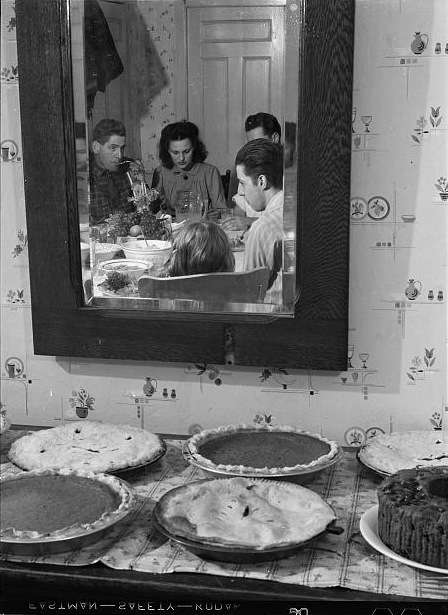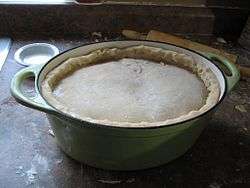In the annals of pie history, New England holds a special place.

A moment in pie history: Pumpkin pies and Thanksgiving dinner at the home of Mr. Timothy Levy Crouch, a Rogerine Quaker living in Ledyard, Connecticut. Photo by Jack Delano, 1940. Photo courtesy Library of Congress.
Pumpkin pie might not have happened without New England, where rhubarb pie is revered in the springtime. In New England’s Little Canadas, Franco-Americans celebrate the Christmas holidays with spiced meat pies called tourtiere. Vermonters favor maple pie, and Boston is the birthplace of the Boston Cream Pie — which really isn’t a pie, but then again neither is Maine’s official state treat, the Whoopie Pie.
The late Robert Cox, head of Special Collections at UMass-Amherst, delved into New England’s pie history in his book, New England Pie: History Under a Crust.
The New England Historical Society interviewed Cox in 2015 about his book on pie history. He has also written about New England chowder and cranberry culture.
Why Pie History?
Cox told us he explores food history because it is one of the most enduring cultural traits. Food preferences will linger for three or four generations as a central part of family ritual and family life.
“It can be more revealing about our attitudes, our hopes and fears, than anything we ever write,” Cox said.
As a historian, Cox said he hesitates to claim New Englanders eat more pie than people in other regions of the United States. But pie culture is definitely deeper in certain parts of the country, he said, and, ‘pie is quite deep here.’
New England’s pie culture does differ from the rest of the United States because it has more of a balance between the savory – the chicken, the turkey or the clam pie – and the sweet – the apple, the pumpkin, the squash, the blueberry or the cream pies.
Cox found it hard to pin down regional pie-eating differences within New England. An apple pie on Cape Cod isn’t that different from an apple pie elsewhere, with the exception of Central Massachusetts. There, Cox said, apple pie is more likely to have raisins in it, something he considers an abomination. And Northern New Englanders are more apt to eat apple pie with cheese.
There are some ethnic variations – Franco-Americans have their tourtiere, Italian-Americans have their ricotta pie and Portuguese-Americans have their custard tarts. Clam pie is stronger on Cape Cod than elsewhere.
In his quest to record pie history, Cox only found maple pie in Vermont.
French Pie History
French meat pies are special, a celebratory food eaten in the shortest days of winter, Cox said. Cooks make them to show how much they care about their family and to show off cooking skills.
Cox’s home town of Easthampton, Mass., has a strong Franco-American presence. There, stores sell French meat pies, traditionally made with ground meat, potato and spices like cloves and allspice.
In New England Pie: History Under a Crust, Cox recounted how he ate a French meat pie with his in-laws – and learned it was made with Bell’s Seasoning. The cook had gotten away from her mother’s recipe. Her daughters didn’t like cloves and allspice, so she substituted the Bell’s. She was mortally embarrassed when Cox found out. But he was okay with it.
“Bell’s is kind of traditional,” he said. “Taking what’s available and meeting the needs of your family is traditional.”
Rhubarb Pie History
People know about rhubarb pie in other parts of the country, but New Englanders eat more of it then they do anywhere else.
Rhubarb originally had a medicinal use as a purgative and laxative. Not until the American Revolution ended was it used in pies. Then in the early 19th century an unnamed genius renamed it ‘pie-plant,’ and rhubarb took off.
Cox was convinced New Englanders love rhubarb because it’s the first fresh produce in the market – a bright presence of the New England spring.
“For two or three months, you would have had older fruits and vegetables and preserves,” he said. “Since the 1790s, it’s really been a New England pie.”
Revolutionary Roots of the Boston Cream Pie
A French chef brought to the Parker House in 1855 invented the Boston Cream Pie. The hotel owner wanted his hotel to be the finest in the country, and needed a good restaurant to earn that reputation. The chef came up with a signature treat, a cake with cream in the middle and a ganache top with chocolate – the distinctive Boston Cream Pie that became a regional favorite.
“It’s very close to pies that weren’t pies floating around New England at the time,” said Cox. People called those false pies Washington Pies, light cakes with a cream or fruit filling. Lafayette Pies resembled the Washington Pies.
“There was an immense nostalgia for the simplicity of that generation,” Cox said. “Naming a dessert after Washington and Lafayette was a way of commemorating the independence and history of the country.”
The Parker House presented the Boston Cream Pie as a high-class, high-status dessert that echoed the Washington and Lafayette pies.
In a note of historical irony, Vietnam’s own revolutionary, Ho Chi Minh, worked in the Parker House bakery and probably made Boston Cream Pie. Another revolutionary, Malcolm X, worked as a waiter in the Parker House and probably served Boston Cream Pie.
This story about New England pie history was updated in 2024.





3 comments
[…] A Fulfilling Story: New England Pie History […]
[…] William Bradford had to put down the celebrations. He went so far as to call the Christmas treat mincemeat pie ‘idolatrie in a […]
[…] reveillon is a long, late dinner preceding a holiday, and central to it is the tourtiere. The celebrated meat pie, cooked and eaten during the shortest days of winter, was often […]
Comments are closed.